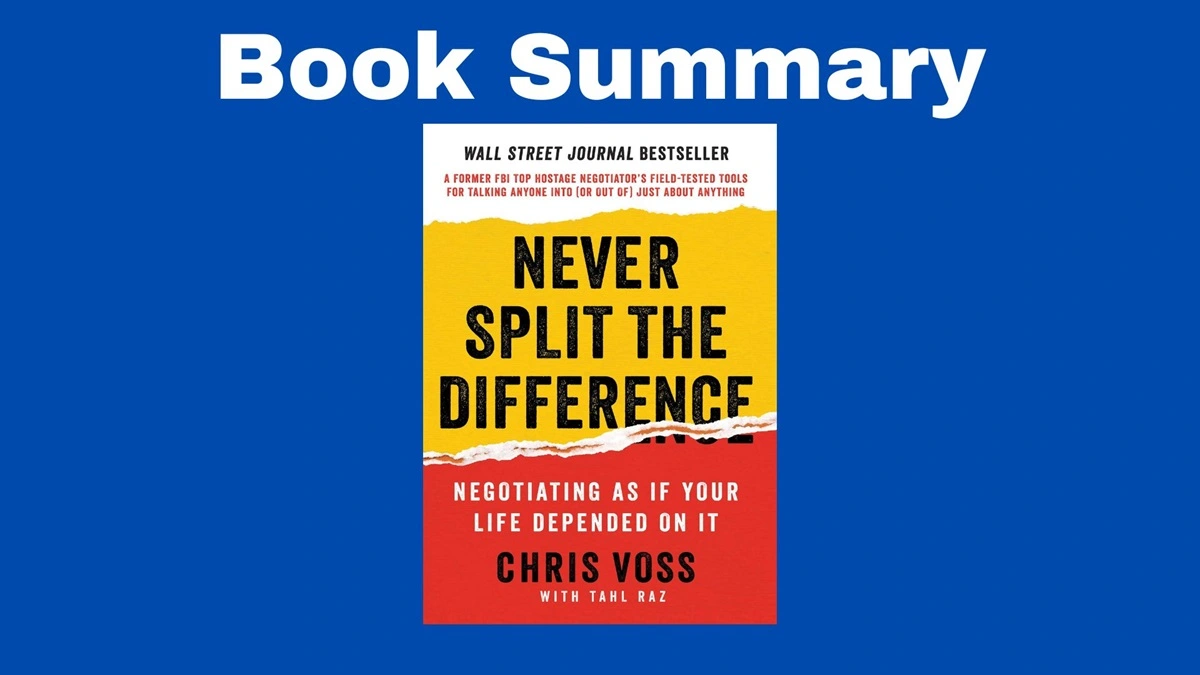The Book in Three Sentences
In this summary of Never Split the Difference, you’ll learn the art of negotiation from a former international hostage negotiator for the FBI. To save lives, Voss learned several skills and the author compiled those strategies in this book. Everything in life involves negotiation from buying a car to deliberating with your partner and this book gives you the tools to come out ahead.
Never Split the Difference Summary
Chapter 1: The New Rules
Chris Voss worked for twenty years in the FBI negotiating hostage situations. Over the years, he learned everything about human interaction to save lives and turned it into a system. Real-world negotiation is one of the hardest skills to learn because it’s unpredictable and complex, so you can’t follow a script. This is how negotiations were treated until Amos Tversky and Daniel Kahneman proved that humans are irrational. Humans suffer from cognitive bias, unconscious and irrational mental processes that distort our worldview. The more they studied this phenomenon, the more biases they discovered.
Kahneman compiled his findings in the book Thinking Fast and Slow where he recognizes two systems of thought. System 1 is fast, intuitive, and emotional. System 2 is slow, deliberate, and logical. It’s worth pointing out that System 1 is the predominant one and as such, it even guides our rational thoughts. Successful negotiators try to affect the other person’s System 1 so that they can influence their System 2. You can’t solve hostage situations rationally because they involve people and people are emotional.
Hostage negotiation has more to do with your life than you think. Everything in life involves negotiating. Everyone wants something from someone else and the interaction that happens requires negotiating. Your ability to negotiate influences every aspect of your life: career, finances, reputation, love life, and your kids’ future. All relationships lead to conflict, but you can get what you want without harming anyone.
Many people dislike negotiating, but you don’t have to intimidate others to be part of it. Negotiation is an inescapable emotional game we all must face at some point. Real hostage negotiators can’t split the difference with a criminal. They must win the emotional intelligence game.
Chapter 2: Be a Mirror
Good negotiators know there will be surprises along the way, so they use their skills to reveal them as soon as possible. As you get new information, you can formulate new hypotheses. The more information you have, the more hypotheses you discard and the closer you get to the truth. The worst thing you can do is make assumptions or develop your conclusions because doing so leads to a flawed version of the situation.
Listening attentively is one of the most important skills you can put into practice when you negotiate. If you don’t, you risk engaging in selective listening, which means you hear what you want. Also, exposing ourselves to too much information easily overwhelms us and you can listen to the voice in your head rather than the other person. This is known as active listening and it’s the first step to disarming your counterpart because you make them feel safe. The more you keep the other person talking, the more trust you gain.
Another common mistake negotiators often commit is going too fast. Building trust takes time. Also, you must keep the person busy instead of letting them do bad things. Whenever possible, use your Late Night, FM DJ Voice which the author describes as “the voice of calm and reason”. The Late Night, FM DJ Voice involves talking slowly and clearly. It implicitly sends the message you’re in control of the situation. You don’t offer alternatives and you don’t invite a response. Alternatively, you can use a positive, playful voice to think quickly, collaborate, and problem-solve. The third voice is direct or assertive which is used rarely and leads to pushback.
Next, you should mirror what the other person is saying. Mirroring is imitation. When we copy someone, we comfort them because it implies bonding and establishing trust. Humans fear what’s different, but are attracted to what’s similar. While mirroring can involve body language, negotiations mirror only words. As you repeat the other person’s last words, they’ll instinctively elaborate on the subject. To connect with strangers, you mirror and use positive reinforcement (phrases like “good job”, “sure”, or “no problem”).
Chapter 3: Don’t Feel Their Pain, Label It
In tense situations, the best advice is to avoid getting emotional. When someone gets emotional, you can’t approach the situation rationally anymore. Good negotiators label emotions and use them as a tool. The key is to listen more and talk less. Once you notice someone’s emotions, you can use them to your advantage. In other words, you must express empathy. This involves seeing the situation from the other party’s perspective and vocalizing that recognition. You can take that even further with tactical empathy where you understand how the person is feeling and what’s behind those feelings. When you enter a negotiation, you shouldn’t care about your goals. When you empathize, you can approach the other party, talk to them, and mold them.
Labeling, on the other hand, involves spotting someone’s feelings and turning them into words. This creates intimacy and reduces the tension. Labeling emotions moves the negotiation to the rational thinking realm and disrupts it. To label emotions, use phrases like “It seems like…” or “It looks like…” Never start with “I” because it signals you’re only interested in yourself. Finally, labeling benefits from silence, so once you’ve used it, be quiet and wait for an answer.
Labeling is a tactic, but how you deploy it determines your success or lack thereof. People’s emotions can be divided into two: the “presenting” feeling is everything you see and hear and the “underlying” feeling is the true reason behind the behavior. Good negotiators label the underlying emotions. This is important because labeling positive emotions reinforces them. When you label fears, the impact they have on you softens.
Alternatively, the author uses what’s known as the accusation audit where he lists everything the counterpart could say about him. As you do this, you label their fears and ask for input. In other words, you start with all the negative parts which puts both parties in a safe zone of empathy. After all, all humans want is to connect and be understood.
Chapter 4: Beware “Yes” – Master “No”
When someone wants to sell you something you don’t want, the last thing you want to say is “Yes”. Saying “No”, on the other hand, feels like salvation. No one wants to say “No” because it feels like the ultimate negative word, but we must see “No” for what it is, pure gold. “No” is the best way to maintain the status quo, while maintaining control of the situation. Unlike “Yes” or “Maybe” (which are often meaningless), “No” changes the course of the conversation.
As counterintuitive as it sounds, starting the negotiation with “No” lets you consider the possibilities. When you say “No”, you signal a temporary decision to keep the status quo. In other words, “No” protects you from change. When you say “No”, the negotiation will become constructive and collaborative. Permitting the other party to say “No” is important because it creates autonomy which is something everyone wants. People have to say “No” at some point and when it comes to negotiating, the sooner they say it, the better.
There are three kinds of “Yes”: Counterfeit, Confirmation, and Commitment. A Counterfeit “Yes” is a way to keep the conversation going even if all you want to say is “No”. A Confirmation “Yes” is a small confirmation that doesn’t lead to action. Finally, a Commitment “Yes” is when you agree to action.
A Counterfeit “Yes” is empty and meaningless. It’s something someone says to make you feel good but leads nowhere. So don’t ask for “Yes”, ask for “No” instead because that leads to safety and control. When you start with “No”, you should pursue a final “Yes” of commitment and when you get there, you know it means something. Although we think “No” means failure and the end of the conversation, it’s the only way forward when negotiating.
Chapter 5: Trigger the Two Words that Immediately Transform Any Negotiation
As part of the negotiation, you must convince the other person of what you’re trying to do. Your job is to make them say “That’s right”. This breakthrough takes time. One way to get there is by summarizing everything that was said before. The author suggests the formula: Paraphrasing + Labeling = Summary. Hearing the phrase “You’re Right” is a disaster. This means they agree in theory, but not in practice. As a consequence, their behavior won’t change. What you want instead is “That’s right” because it shows real understanding between the parties involved.
Chapter 6: Bend Their Reality
In life-and-death negotiating, most people’s reaction is to give kidnappers whatever they want so that no one gets hurt. The problem is that there’s always leverage. Negotiating is incredibly messy and many unknown variables come into play. A win-win situation would be to split the difference (offering the counterpart half of what they ask for and keeping the other half), but this often leads to disastrous consequences. As a general rule, Voss suggests you never split the difference.
The most critical variable in negotiation is time. Deadlines pressure you to make fast decisions so that the deal ends once and for all. Good negotiators avoid making quick decisions, but missing a deadline rarely has negative repercussions. Also, there’s no such thing as fair. When you split the difference, you’re making an irrational and emotional decision. Seeing something as unfair will make you angry and you’ll feel manipulated regardless of what you got as part of the deal.
When you change one or two variables, you can bend reality from insult to victory. Even if the value of something doesn’t change, your perspective can and in negotiation, perspective makes all the difference. Again, this supports the idea that we’re irrational, but that doesn’t mean we don’t follow certain patterns. The best theory of irrational decisions is the Prospect Theory. In certain situations that involve risk, people are attracted to sure outcomes over probabilities. This is known as the Certainty Effect. Moreover, people want to avoid losses more than they want to obtain gains. This is called Loss Aversion. Considering loss aversion, your job is to persuade the other party that they have something to lose if the deal goes through.
The author compiled some tactics from prospect theory you can use.
- Anchor their emotion: this involves acknowledging the other party’s fears. The mere mention of potential losses means they’ll do anything to avoid it.
- Let the other guy go first… most of the time: in negotiations that involve money, you can ruin your potential gains by going first. If you’re lucky, the other party might offer more than you had in mind.
- Establish a range: this is establishing a ballpark figure you’re comfortable with.
- Pivot to nonmonetary terms: if some part is unhappy with the price, you can pivot to nonmonetary terms. If the price is good for you, but not the other party, you can offer important things to them. If the price is not good for you, you can demand things that matter to you, but not to them.
- When you do talk numbers, use odd ones: numbers that end in 0 feel like guestimates. Specific sums seem well thought out.
- Surprise with a gift: when you make a good gesture with someone, they feel the need to repay your kindness somehow.
Chapter 7: Create the Illusion of Control
Successful negotiation involves getting your counterpart to do all the heavy lifting for you and suggesting a solution themselves. When you define the conversation, you also create the illusion of control.
Asking close-ended questions that only have a single correct answer is a mistake. You want to ask open-ended and calibrated questions that make your counterpart think about the best way to solve the problem. These often come in the form of “how” questions. A great benefit of this technique is that you’re not imposing your point of view. Calibrated questions guide the other person toward a specific problem, but there are rules.
First, your questions can’t be answered with a “Yes” or “No”, so you should start with “What” and “How”. Second, for this to work, you must have self-control. Regulating your emotions is important if you want to keep the upper hand. So avoid passionate reactions and don’t counterattack when you’re verbally assaulted.
Chapter 8: Guarantee Execution
- Negotiators must get to an agreement and make sure that it happens. Their role is to gain consent and execution or, in other words, they must get to “Yes” and “How”. “How” questions are powerful because they pressure your counterpart which buys you time. Also, “How” questions are a gentle way to say “No”, so you can use them to guide your counterpart to a better solution. Just make sure every member is on board.
- The art of negotiating involves dealing with liars and jerks. Although some can be aggressive, you must ignore that and learn to spot the subtleties underneath their aggression. This involves getting good at interpreting what is said, as well as what isn’t.
- You must identify liars, disarm jerks, and charm everyone else. One way to do this is by using open-ended “How” questions, but there are more strategies.
- A good strategy against aggressive people is to turn their aggression against themselves, so you simply absorb their threats until they’re tired.
- Another strategy is known as the 7-38-55 percent rule which states that 7 percent of a message is words, 38 percent is the tone of voice, and 55 percent is body language. When the body language and tone of voice don’t align with the message, the person lies.
- To avoid a counterfeit “Yes” (a “Yes” that means “No”), you use the Rule of Three. The idea is to get your counterpart to agree to something three times.
- The Pinnochio Effect involves looking at telltale signs when the other person is lying. Liars usually use too many words and more third-person pronouns, for instance. Furthermore, when they use “I”, “Me”, and “My” too many times, that means they’re not that important.
- The Chris discount involves using the hostages’ names to humanize them. This makes it less likely that they’ll get harmed. If someone wants to fight you, as counterintuitive as it sounds, introducing yourself by name might disarm the aggressor. When you humanize yourself by saying your name in a friendly manner, the reward you get is nonaggression.
Chapter 9: Bargain Hard
Bargaining is an uncomfortable ballet of offers and counteroffers, but the moment you embrace it, you have an edge over everyone else. When bargaining, people fall into three categories: Accommodators, Assertive, and Analysts.
- Analysts are systematic and careful. They want to minimize mistakes and take their time to get things right. However, they seem cold and distant which puts people off. Analysts pay attention to small details because they hate surprises. They’re skeptical by nature, so their counteroffers take time. To deal with analysts, use facts.
- Accommodators spend a long time building the relationship. They like exchanging information because their ultimate goal is a win-win scenario. They’re trendy and pleasant to be around. Since they focus so much on the other person, they lack preparation. Unfortunately, too much chitchat leads to meaningless interactions where deals don’t happen.
- Assertive people want to accomplish as much as they can in as little time as possible. Their ultimate goal is to win and they couldn’t care less about the “perfect” solution. Their communication style is aggressive because they want to be heard. To disarm the assertive type, use mirrors, calibrated questions, and summaries.
It’s important to be aware of the different negotiating styles, but it’s also important to identify which style represents you the most.
Chapter 10: Find the Black Swan
Black Swans are unexpected pieces of information. This is when something happens despite looking like it’s impossible. Examples include Pearl Harbor, 9/11, and the pandemic. Nobody could have predicted those events, though, in hindsight, there were telltale signs everywhere. When you base your predictions on previous experience, you will miss events. Those are Black Swans.
In negotiations, there are known knowns. These include all the things we know. Then, there are known unknowns. These are the things we don’t know, but we can anticipate. Finally, we have unknown unknowns which are all the things we don’t know and we can’t anticipate. These are Black Swans.
Everyone can benefit from finding Black Swans, but this is, by definition, almost impossible to do. After all, how can we know what we don’t know? Black Swans are useful because they’re leverage multipliers. In other words, they give you a big advantage. When you have leverage, you have less to lose. The author recognizes three types of leverage:
- Positive Leverage: this is your ability to provide things your counterpart wants. This gives you power.
- Negative Leverage: this is your ability to make your counterpart suffer. This often comes in the form of threats. Making threats can lead to serious consequences if you’re not careful.
- Normative Leverage: everyone has a moral framework. When someone says one thing but shows a different belief, then you have normative leverage.
Black Swans live on your counterpart’s “religion” (the worldview they carry with them wherever they go). Getting face time with your counterpart also helps and so does sharing common ground.
Further Reading
If you enjoyed this book summary of Never Split the Difference, you might also like the following articles:




